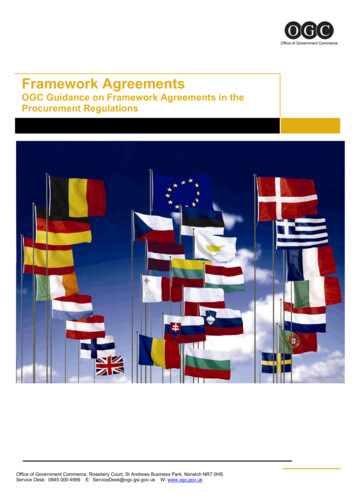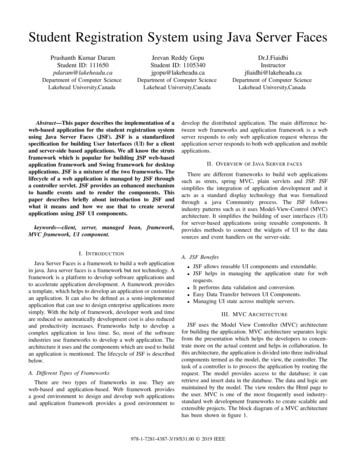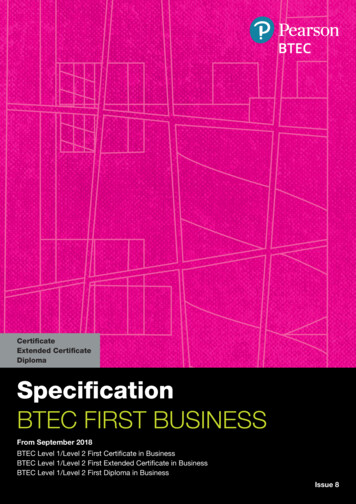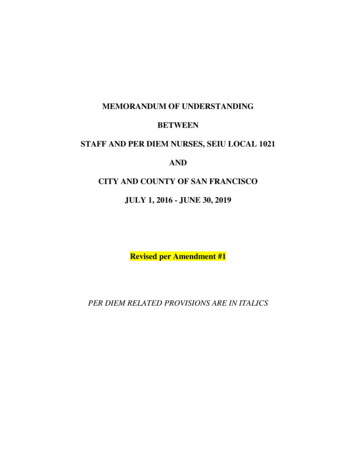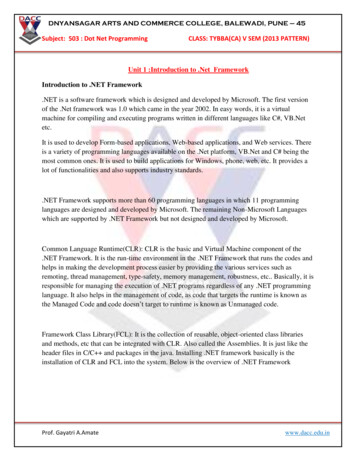
Transcription
DNYANSAGAR ARTS AND COMMERCE COLLEGE, BALEWADI, PUNE – 45Subject: 503 : Dot Net ProgrammingCLASS: TYBBA(CA) V SEM (2013 PATTERN)Unit 1 :Introduction to .Net FrameworkIntroduction to .NET Framework.NET is a software framework which is designed and developed by Microsoft. The first versionof the .Net framework was 1.0 which came in the year 2002. In easy words, it is a virtualmachine for compiling and executing programs written in different languages like C#, VB.Netetc.It is used to develop Form-based applications, Web-based applications, and Web services. Thereis a variety of programming languages available on the .Net platform, VB.Net and C# being themost common ones. It is used to build applications for Windows, phone, web, etc. It provides alot of functionalities and also supports industry standards.NET Framework supports more than 60 programming languages in which 11 programminglanguages are designed and developed by Microsoft. The remaining Non-Microsoft Languageswhich are supported by .NET Framework but not designed and developed by Microsoft.Common Language Runtime(CLR): CLR is the basic and Virtual Machine component of the.NET Framework. It is the run-time environment in the .NET Framework that runs the codes andhelps in making the development process easier by providing the various services such asremoting, thread management, type-safety, memory management, robustness, etc. Basically, it isresponsible for managing the execution of .NET programs regardless of any .NET programminglanguage. It also helps in the management of code, as code that targets the runtime is known asthe Managed Code and code doesn’t target to runtime is known as Unmanaged code.Framework Class Library(FCL): It is the collection of reusable, object-oriented class librariesand methods, etc that can be integrated with CLR. Also called the Assemblies. It is just like theheader files in C/C and packages in the java. Installing .NET framework basically is theinstallation of CLR and FCL into the system. Below is the overview of .NET FrameworkProf. Gayatri A.Amatewww.dacc.edu.in
DNYANSAGAR ARTS AND COMMERCE COLLEGE, BALEWADI, PUNE – 45Subject: 503 : Dot Net ProgrammingCLASS: TYBBA(CA) V SEM (2013 PATTERN)Is .NET application platform dependent or platform independent?The combination of Operating System Architecture and CPU Architecture is known as theplatform. Platform dependent means the programming language code will run only on particularOperating System. A .NET application is platform dependent because of the .NET frameworkwhich is only able to run on the Windows-based operating system. The .Net application isplatform independent also because of Mono framework. Using Mono framework the .Netapplication can run on any Operating System including windows. Mono framework is a thirdparty software developed by Novell Company which is now a part of Micro Focus Company. Itis a paid frameworkProf. Gayatri A.Amatewww.dacc.edu.in
DNYANSAGAR ARTS AND COMMERCE COLLEGE, BALEWADI, PUNE – 45Subject: 503 : Dot Net ProgrammingCLASS: TYBBA(CA) V SEM (2013 PATTERN)Event-driven programming focuses on events. Eventually, the flow of program depends uponevents. Until now, we were dealing with either sequential or parallel execution model but themodel having the concept of event-driven programming is called asynchronous model. Eventdriven programming depends upon an event loop that is always listening for the new incomingevents. The working of event-driven programming is dependent upon events. Once an eventloops, then events decide what to execute and in what order. Following flowchart will help youunderstand how this works .Net Framework ArchitectureThe basic architecture of the .Net framework is as shown below.Prof. Gayatri A.Amatewww.dacc.edu.in
DNYANSAGAR ARTS AND COMMERCE COLLEGE, BALEWADI, PUNE – 45Subject: 503 : Dot Net ProgrammingCLASS: TYBBA(CA) V SEM (2013 PATTERN).NET ComponentsThe architecture of the .Net framework is based on the following key components;1. Common Language RuntimeThe "Common Language Infrastructure" or CLI is a platform on which the .Net programs areexecuted.The CLR has the following key features:Exception Handling - Exceptions are errors which occur when the application is executed.Examples of exceptions are:If an application tries to open a file on the local machine, but the file is not present.If the application tries to fetch some records from a database, but the connection to the databaseis not valid.Garbage Collection - Garbage collection is the process of removing unwanted resources whenthey are no longer required.Examples of garbage collection areProf. Gayatri A.Amatewww.dacc.edu.in
DNYANSAGAR ARTS AND COMMERCE COLLEGE, BALEWADI, PUNE – 45Subject: 503 : Dot Net ProgrammingCLASS: TYBBA(CA) V SEM (2013 PATTERN)A File handle which is no longer required. If the application has finished all operations on a file,then the file handle may no longer be required.The database connection is no longer required. If the application has finished all operations on adatabase, then the database connection may no longer be required.Working with Various programming languages –As noted in an earlier section, a developer can develop an application in a variety of .Netprogramming languages.Language - The first level is the programming language itself, the most common ones areVB.Net and C#.Compiler – There is a compiler which will be separate for each programming language. Sounderlying the VB.Net language, there will be a separate VB.Net compiler. Similarly, for C#,you will have another compiler.Common Language Interpreter – This is the final layer in .Net which would be used to run a .netprogram developed in any programming language. So the subsequent compiler will send theprogram to the CLI layer to run the .Net application.Prof. Gayatri A.Amatewww.dacc.edu.in
DNYANSAGAR ARTS AND COMMERCE COLLEGE, BALEWADI, PUNE – 45Subject: 503 : Dot Net ProgrammingCLASS: TYBBA(CA) V SEM (2013 PATTERN)2. Class LibraryThe .NET Framework includes a set of standard class libraries. A class library is a collection ofmethods and functions that can be used for the core purpose.For example, there is a class library with methods to handle all file-level operations. So there is amethod which can be used to read the text from a file. Similarly, there is a method to write text toa file.Most of the methods are split into either the System.* or Microsoft.* namespaces. (The asterisk *just means a reference to all of the methods that fall under the System or Microsoft namespace)A namespace is a logical separation of methods. We will learn these namespaces more in detailin the subsequent chapters.3. LanguagesThe types of applications that can be built in the .Net framework is classified broadly into thefollowing categories.WinForms – This is used for developing Forms-based applications, which would run on an enduser machine. Notepad is an example of a client-based application.ASP.Net – This is used for developing web-based applications, which are made to run on anybrowser such as Internet Explorer, Chrome or Firefox.The Web application would be processed on a server, which would have Internet InformationServices Installed.Internet Information Services or IIS is a Microsoft component which is used to execute anAsp.Net application.The result of the execution is then sent to the client machines, and the output is shown in thebrowser.Prof. Gayatri A.Amatewww.dacc.edu.in
DNYANSAGAR ARTS AND COMMERCE COLLEGE, BALEWADI, PUNE – 45Subject: 503 : Dot Net ProgrammingCLASS: TYBBA(CA) V SEM (2013 PATTERN)ADO.Net – This technology is used to develop applications to interact with Databases such asOracle or Microsoft SQL Server.Microsoft always ensures that .Net frameworks are in compliance with all the supportedWindows operating systems.Net Framework Design PrincipleThe following design principles of the .Net framework are what make it very relevant to create.Net based applications.Interoperability - The .Net framework provides a lot of backward support. Suppose if you hadan application built on an older version of the .Net framework, say 2.0. And if you tried to runthe same application on a machine which had the higher version of the .Net framework, say 3.5.The application would still work. This is because with every release, Microsoft ensures that olderframework versions gel well with the latest version.Portability- Applications built on the .Net framework can be made to work on any Windowsplatform. And now in recent times, Microsoft is also envisioning to make Microsoft productswork on other platforms, such as iOS and Linux.Security - The .NET Framework has a good security mechanism. The inbuilt securitymechanism helps in both validation and verification of applications. Every application canexplicitly define their security mechanism. Each security mechanism is used to grant the useraccess to the code or to the running program.Memory management - The Common Language runtime does all the work or memorymanagement. The .Net framework has all the capability to see those resources, which are notused by a running program. It would then release those resources accordingly. This is done via aprogram called the "Garbage Collector" which runs as part of the .Net framework.The garbage collector runs at regular intervals and keeps on checking which system resources arenot utilized, and frees them accordingly.Simplified deployment - The .Net framework also have tools, which can be used to packageapplications built on the .Net framework. These packages can then be distributed to clientmachines. The packages would then automatically install the application.Prof. Gayatri A.Amatewww.dacc.edu.in
DNYANSAGAR ARTS AND COMMERCE COLLEGE, BALEWADI, PUNE – 45Subject: 503 : Dot Net ProgrammingCLASS: TYBBA(CA) V SEM (2013 PATTERN)In this chapter, we will understand the execution process of .NET Core and compare it with the.NET Framework. The managed execution process includes the following steps. Choosing a compilerCompiling your code to MSILCompiling MSIL to native codeRunning codeChoosing a Compiler It is a multi-language execution environment, the runtime supports a wide variety of datatypes and language features.To obtain the benefits provided by the common language runtime, you must use one ormore language compilers that target the runtime.Compiling your code to MSIL Compiling translates your source code into Microsoft Intermediate Language (MSIL) andgenerates the required metadata.Metadata describes the types in your code, including the definition of each type, thesignatures of each type's members, the members that your code references, and other datathat the runtime uses at execution time.The runtime locates and extracts the metadata from the file as well as from frameworkclass libraries (FCL) as needed during execution.Prof. Gayatri A.Amatewww.dacc.edu.in
DNYANSAGAR ARTS AND COMMERCE COLLEGE, BALEWADI, PUNE – 45Subject: 503 : Dot Net ProgrammingCLASS: TYBBA(CA) V SEM (2013 PATTERN)Compiling MSIL to Native Code At execution time, a just-in-time (JIT) compiler translates the MSIL into native code.During this compilation, code must pass a verification process that examines the MSILand metadata to find out whether the code can be determined to be type safe.Running Code The common language runtime provides the infrastructure that enables the execution totake place and services that can be used during execution.During execution, managed code receives services such as garbage collection, security,interoperability with unmanaged code, cross-language debugging support, and enhanceddeployment andFeatures of .NET Framework Common Language Runtime (CLR) .NET Framework Class Library (FCL) Interoperability Common Type System (CTS) Asynchronous Programming Portability High Performance Memory Management SecurityProf. Gayatri A.Amatewww.dacc.edu.in
DNYANSAGAR ARTS AND COMMERCE COLLEGE, BALEWADI, PUNE – 45Subject: 503 : Dot Net ProgrammingCLASS: TYBBA(CA) V SEM (2013 PATTERN)IDE (integrated Development Environment) It is a software application that provides comprehensive facilities to computerprogrammers for software development.In general IDE is a graphical user interface based workbench which helps the developer inbuilding software applications by providing tools like a source code editor; build automationtools, a debugger etcIn the context of .NET based applications, visual studio is the most commonly used IDE.VS.Net is just an editor, provided by Microsoft to help developers to write .NET programseasily.VS.Net provides:1. Editor which automatically generate lot of code.2. Allow developers to drag and drop control to a form.3. Provide shortcuts to compile and build the application etc.Event driven programming Changing the state of an object is known as an event. For example click on button,dragging mouse etc. Event handling is the mechanism that controls the event and decideswhat should happen if an event occurs.Event driven programming is a paradigm in which the flow of the program is determinedby events (mouse clicks, key presses), sensor outputs, or messages from otherprograms/threads.In in fig a simple event driven programming paradigm where each and every event gothrough a scheduler. Scheduler passes the code written inside the events to a particularevent handler.EventsSchedulerEvent-handler1Prof. Gayatri A.AmateEvent-handler2Event-handler3www.dacc.edu.in
DNYANSAGAR ARTS AND COMMERCE COLLEGE, BALEWADI, PUNE – 45Subject: 503 : Dot Net ProgrammingCLASS: TYBBA(CA) V SEM (2013 PATTERN)VB.net support event driven programming by following ways: A Visual studio IDE provides toolbox which is a window that gives us access to allcontrols, components, etc. User can easily drag and drop controls or tools on forms.A Visual studio IDE also provides editor which automatically generates codes fordifferent events like click or press events. The programmer therefore concentrate onissues such as interface design, which involves adding controls such as command buttons,text boxes, and labels to standard formsOnce the user interface is substantially complete, the programmer can add event-handlingcode to each control as required.Each event-handler is usually bound to a specific object or control on a form. Anyadditional subroutines, methods, or function procedures required are usually placed in aseparate code module, and can be called from other parts of the program as and whenneeded.NET Framework: Assemblies and namespaces are basic building blocks of the .net framework, They formthe fundamental unit of deployment, version control, reuse , security permissions andmore.Assemblies: An assembly is a collection of types and resources that are built to work together andform a logical unit of functionality.Prof. Gayatri A.Amatewww.dacc.edu.in
DNYANSAGAR ARTS AND COMMERCE COLLEGE, BALEWADI, PUNE – 45Subject: 503 : Dot Net ProgrammingCLASS: TYBBA(CA) V SEM (2013 PATTERN)Manifest:Manifest is the most important part of an Assembly. Manifest contains useful information, aboutan assembly which makes an assembly: self-describing,The specifications in an assembly are collectively referred to as the assembly’s the manifestcontains:1. The name of the assembly.2. Version information for the assembly.3. Security information for the assembly.4. A list of all files that are part of the assembly.5. Type reference information for the types specified in the assembly.6. A list of other assemblies that are referenced by the assembly.7. Custom information, such as user-friendly assembly title, description and product information,Prof. Gayatri A.Amatewww.dacc.edu.in
DNYANSAGAR ARTS AND COMMERCE COLLEGE, BALEWADI, PUNE – 45Subject: 503 : Dot Net ProgrammingCLASS: TYBBA(CA) V SEM (2013 PATTERN)2. System Namespaces: Namespace plays a fundamental role in the .Net framework. You cannot build a vb.netapplication without using classes from the .net system namespace.The .net framework class library consists of several thousand classes and other types,(such as interfaces, structures and enumerations) that are divided into several namespacesMost commonly used namespaces are as follows:1. System.Data: System.Data and its nested namespaces, notably system.Data.oledb andsystem.data.sqlclient provide data access using ADO.NETThe oledb and sqlclient namespaces are responsible for defining data providers that canconnect to a data source retrieve data from a data source, write data back to a datasource and execute commands against the data source.ADO.net is an entirely new model for data access that is based on the disconnected dataset.2.System.IO:The system.IO namespace contains classes that provide a variety of input/output functionality,such as Manipulating directories and filesMonitoring changes in directories and filesReading and writing single bytes, multi byte blocks or characters to and from streams.Reading and writing characters to and from stringsWriting and reading data types and objects to and from streamsProviding random access to files(file stream)Prof. Gayatri A.Amatewww.dacc.edu.in
DNYANSAGAR ARTS AND COMMERCE COLLEGE, BALEWADI, PUNE – 45Subject: 503 : Dot Net ProgrammingCLASS: TYBBA(CA) V SEM (2013 PATTERN)3. System.Text.RegularExpressions: The system.Text.RegularExpressions namespace contains classes that provide access tothe .NET frameworks regular expression engine.In its simplest form a regular expression is a text string that represents a pattern that otherstrings may or may not match.4.System.windows.forms This namespace is the mother of all namespaces and is used for creating windowsapplications.The system.Window.Forms namesqace contains classes for creating windows basedapplications that take full advantage of the rich user interface features available in theMicrosoft windows operating system.In this namespace you will find the form class and many other controls that can be addedto forms to create user interfaces.In fact each new form added to a vb.net Project contains the following line:Imports System.Window.FormsFortunately visual studio provides the functionality of the system.window.formsnamespace to us as vb programmers, so we do not need to program directly against thisnamespace.Architecture of .NET Framework.NET Framework ٭ Microsoft .NET (pronounced “dot net”) is a software component that runs on theWindows operating system. ٭ .NET provides tools and libraries that enable developers to create Windows softwaremuch faster and easier. ٭ The .NET Framework must be installed on a user’s PC to run .NET applications.Prof. Gayatri A.Amatewww.dacc.edu.in
DNYANSAGAR ARTS AND COMMERCE COLLEGE, BALEWADI, PUNE – 45Subject: 503 : Dot Net ProgrammingCLASS: TYBBA(CA) V SEM (2013 PATTERN)NET Framework.Net Framework.NET is a framework to develop software applications. It is designed and developed by Microsoftand the first beta version released in 2000.It is used to develop applications for web, Windows, phone. Moreover, it provides a broad rangeof functionalities and support.This framework contains a large number of class libraries known as Framework Class Library(FCL). The software programs written in .NET are executed in the execution environment, whichis called CLR (Common Language Runtime). These are the core and essential parts of the .NETframework.This framework provides various services like memory management, networking, security,memory management, and type-safety.The .Net Framework supports more than 60 programming languages such as C#, F#, VB.NET,J#, VC , JScript.NET, APL, COBOL, Perl, Oberon, ML, Pascal, Eiffel, Smalltalk, Python,Cobra, ADA, etc.Following is the .NET framework Stack that shows the modules and components of theFramework.The .NET Framework is composed of four main components:Common Language Runtime (CLR)Framework Class Library (FCL),Core Languages (WinForms, ASP.NET, and ADO.NET), andProf. Gayatri A.Amatewww.dacc.edu.in
DNYANSAGAR ARTS AND COMMERCE COLLEGE, BALEWADI, PUNE – 45Subject: 503 : Dot Net ProgrammingCLASS: TYBBA(CA) V SEM (2013 PATTERN)Other Modules (WCF, WPF, WF, Card Space, LINQ, Entity Framework, Parallel LINQ, TaskParallel Library, etc.)CLR (Common Language Runtime)It is a program execution engine that loads and executes the program. It converts the programinto native code. It acts as an interface between the framework and operating system. It doesexception handling, memory management, and garbage collection. Moreover, it providessecurity, type-safety, interoperability, and portablility. A list of CLR components are givenbelow:Prof. Gayatri A.Amatewww.dacc.edu.in
DNYANSAGAR ARTS AND COMMERCE COLLEGE, BALEWADI, PUNE – 45Subject: 503 : Dot Net ProgrammingCLASS: TYBBA(CA) V SEM (2013 PATTERN)FCL (Framework Class Library)It is a standard library that is a collection of thousands of classes and used to build anapplication. The BCL (Base Class Library) is the core of the FCL and provides basicfunctionalities.Prof. Gayatri A.Amatewww.dacc.edu.in
DNYANSAGAR ARTS AND COMMERCE COLLEGE, BALEWADI, PUNE – 45Subject: 503 : Dot Net ProgrammingCLASS: TYBBA(CA) V SEM (2013 PATTERN)WinFormsWindows Forms is a smart client technology for the .NET Framework, a set of managed librariesthat simplify common application tasks such as reading and writing to the file system.ASP.NETASP.NET is a web framework designed and developed by Microsoft. It is used to developwebsites, web applications, and web services. It provides a fantastic integration of HTML, CSS,and JavaScript. It was first released in January 2002.ADO.NETProf. Gayatri A.Amatewww.dacc.edu.in
DNYANSAGAR ARTS AND COMMERCE COLLEGE, BALEWADI, PUNE – 45Subject: 503 : Dot Net ProgrammingCLASS: TYBBA(CA) V SEM (2013 PATTERN)ADO.NET is a module of .Net Framework, which is used to establish a connection betweenapplication and data sources. Data sources can be such as SQL Server and XML. ADO .NETconsists of classes that can be used to connect, retrieve, insert, and delete data.WPF (Windows Presentation Foundation)Windows Presentation Foundation (WPF) is a graphical subsystem by Microsoft for renderinguser interfaces in Windows-based applications. WPF, previously known as "Avalon", wasinitially released as part of .NET Framework 3.0 in 2006. WPF uses DirectX.WCF (Windows Communication Foundation)It is a framework for building service-oriented applications. Using WCF, you can send data asasynchronous messages from one service endpoint to another.WF (Workflow Foundation)Windows Workflow Foundation (WF) is a Microsoft technology that provides an API, an inprocess workflow engine, and a rehostable designer to implement long-running processes asworkflows within .NET applications.LINQ (Language Integrated Query)It is a query language, introduced in .NET 3.5 framework. It is used to make the query for datasources with C# or Visual Basics programming languages.Entity FrameworkIt is an ORM based open source framework which is used to work with a database using .NETobjects. It eliminates a lot of developers effort to handle the database. It is Microsoft'srecommended technology to deal with the database.Prof. Gayatri A.Amatewww.dacc.edu.in
DNYANSAGAR ARTS AND COMMERCE COLLEGE, BALEWADI, PUNE – 45Subject: 503 : Dot Net ProgrammingCLASS: TYBBA(CA) V SEM (2013 PATTERN)Parallel LINQParallel LINQ or PLINQ is a parallel implementation of LINQ to objects. It combines thesimplicity and readability of LINQ and provides the power of parallel programming.It can improve and provide fast speed to execute the LINQ query by using all available computercapabilities.Apart from the above features and libraries, .NET includes other APIs and Model to improve andenhance the .NET framework.In 2015, Task parallel and Task parallel libraries were added. In .NET 4.5, a task-basedasynchronous model was added.Prof. Gayatri A.Amatewww.dacc.edu.in
DNYANSAGAR ARTS AND COMMERCE COLLEGE, BALEWADI, PUNE – 45Subject: 503 : Dot Net ProgrammingCLASS: TYBBA(CA) V SEM (2013 PATTERN)Unit :2 Introduction to VB.NetWhat is VB.Net?VB.NET stands for Visual Basic.NET, and it is a computer programming language developed byMicrosoft. It was first released in 2002 to replace Visual Basic 6. VB.NET is an object-orientedprogramming language. This means that it supports the features of object-oriented programmingwhich include encapsulation, polymorphism, abstraction, and inheritance.VB.NET FeaturesVB.NET comes loaded with numerous features that have made it a popular programminglanguage amongst programmers worldwide. These features include the following: VB.NET is not case sensitive like other languages such as C and Java.It is an object-oriented programming language. It treats everything as an object.Automatic code formatting, XML designer, improved object browser etc.Garbage collection is automated.Support for Boolean conditions for decision making.Simple multithreading, allowing your apps to deal with multiple tasks simultaneously.Simple generics.A standard library.Events management.References. You should reference an external object that is to be used in a VB.NETapplication.Attributes, which are tags for providing additional information regarding elements thathave been defined within a program.Windows Forms- you can inherit your form from an already existing form.Advantages of VB.NETThe following are the pros/benefits you will enjoy for coding in VB.NET: Your code will be formatted automatically.You will use object-oriented constructs to create an enterprise-class code.You can create web applications with modern features like performance counters, eventlogs, and file system.You can create your web forms with much ease through the visual forms designer. Youwill also enjoy drag and drop capability to replace any elements that you may need.Prof. Gayatri A.Amatewww.dacc.edu.in
DNYANSAGAR ARTS AND COMMERCE COLLEGE, BALEWADI, PUNE – 45Subject: 503 : Dot Net Programming CLASS: TYBBA(CA) V SEM (2013 PATTERN)You can connect your applications to other applications created in languages that run onthe .NET framework.You will enjoy features like docking, automatic control anchoring, and in-place menueditor all good for developing web applications.Disadvantages of VB.NETBelow are some of the drawbacks/cons associated with VB.NET: VB.NET cannot handle pointers directly. This is a significant disadvantage since pointersare much necessary for programming. Any additional coding will lead to many CPUcycles, requiring more processing time. Your application will become slow.VB.NET is easy to learn. This has led to a large talent pool. Hence, it may be challengingto secure a job as a VB.NET programmer.Data typesData types refer to an extensive system used for declaring variables or functions of differenttypes. The type of a variable determines how much space it occupies in storage and how the bitpattern stored is interpreted.Data Types Available in VB.NetVB.Net provides a wide range of data types. The following table shows all the data typesavailable Data TypeStorage AllocationValue RangeBooleanDepends on implementing platformTrue or FalseByte1 byte0 through 255 (unsigned)Char2 bytes0 through 65535 (unsigned)Date8 bytes0:00:00 (midnight) on January 1, 0001 through11:59:59 PM on December 31, 9999Prof. Gayatri A.Amatewww.dacc.edu.in
DNYANSAGAR ARTS AND COMMERCE COLLEGE, BALEWADI, PUNE – 45Subject: 503 : Dot Net ProgrammingCLASS: TYBBA(CA) V SEM (2013 PATTERN)Decimal16 bytes0 through /79,228,162,514,264,337,593,543,950,335 ( /7.9.E 28) with no decimal point; 0 through /7.9228162514264337593543950335 with 28places to the right of the decimalDouble8 bytes-1.79769313486231570E 308through4.94065645841246544E-324, for negative 231570E 308, for positive valuesInteger4 bytes-2,147,483,648 through 2,147,483,647 (signed)Long8 bytes-9,223,372,036,854,775,808 through9,223,372,036,854,775,807(signed)Object4 bytes on 32-bit platformAny type can be stored in a variable of typeObject8 bytes on 64-bit platformSByte1 byte-128 through 127 (signed)Short2 bytes-32,768 through 32,767 (signed)Single4 bytes-3.4028235E 38 through -1.401298E-45 fornegative values;1.401298E-45 throughpositive values3.4028235E 38forStringDepends on implementing platform0 to approximately 2 billion Unicode charactersUInteger4 bytes0 through 4,294,967,295 (unsigned)ULong8 bytes0 through 18,446,744,073,709,551,615 (unsigned)User-DefinedDepends on implementing platformEach member of the structure has a rangedetermined by its data type and independent of theranges of the other membersProf. Gayatri A.Amatewww.dacc.edu.in
DNYANSAGAR ARTS AND COMMERCE COLLEGE, BALEWADI, PUNE – 45Subject: 503 : Dot Net ProgrammingUShort2 bytesCLASS: TYBBA(CA) V SEM (2013 PATTERN)0 through 65,535 (unsigned)VB.Net is an object-oriented programming language. In Object-Oriented Programmingmethodology, a program consists of various objects that interact with each other by means ofactions. The actions that an object may take are called methods. Objects of the same kind aresaid to have the same type or, more often, are said to be in the same class.When we consider a VB.Net program, it can be defined as a collection of objects thatcommunicate via invoking each other's methods. Let us now briefly look into what do class,object, methods and instance variables mean. Object Objects have states and behaviors. Example: A dog has states - color, name,breed as well as behaviors - wagging, barking, eating, etc. An object is an instance of aclass. Class A class can be defined as a template/blueprint that describes the behaviors/statesthat objects of its type support. Methods A method is basically a behavior. A class can contain many methods. It is inmethods where the logics are written, data is manipulated and all the actions areexecuted. Instance Variables Each object has its unique set of instance variables. An object'sstate is created by the values
Unit 1 :Introduction to .Net Framework Introduction to .NET Framework .NET is a software framework which is designed and developed by Microsoft. The first version of the .Net framework was 1.0 which came in the year 2002. In easy words, it is a virtual machine for compiling and executing programs written in different languages like C#, VB.Net etc.





